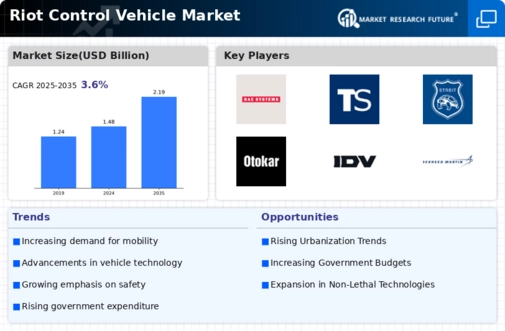Increasing Urbanization
The Global Riot Control Vehicle Market Industry is experiencing growth driven by rapid urbanization across various regions. As cities expand, the potential for civil unrest and protests increases, necessitating the deployment of specialized vehicles for crowd management. Urban areas, with their dense populations, often witness demonstrations that require effective control measures. This trend is particularly evident in developing nations, where urban centers are burgeoning. The demand for riot control vehicles is expected to rise as governments prioritize public safety, contributing to the market's projected value of 1.48 USD Billion in 2024 and an anticipated growth to 2.19 USD Billion by 2035.
Global Political Climate
The Global Riot Control Vehicle Market Industry is also shaped by the prevailing political climate across various nations. Political tensions and social movements often lead to protests, necessitating the deployment of riot control vehicles. In regions where political dissent is common, governments are more likely to invest in advanced riot control solutions to maintain order. This investment is not only a response to immediate needs but also a proactive measure to prevent potential escalations. As the political landscape continues to evolve, the demand for effective riot control vehicles is expected to rise, contributing to the overall growth of the market.
Rising Security Concerns
The Global Riot Control Vehicle Market Industry is significantly influenced by rising security concerns globally. As incidents of civil unrest and protests become more frequent, governments are compelled to invest in riot control measures. This heightened focus on security is particularly pronounced in regions experiencing political instability or social unrest. Law enforcement agencies are increasingly recognizing the necessity of specialized vehicles to effectively manage large crowds and ensure public safety. Consequently, the market is expected to expand, with projections indicating a growth from 1.48 USD Billion in 2024 to 2.19 USD Billion by 2035, reflecting the urgent need for enhanced riot control capabilities.
Market Growth Projections
The Global Riot Control Vehicle Market Industry is projected to experience substantial growth over the next decade. With an estimated market value of 1.48 USD Billion in 2024, the industry is anticipated to reach 2.19 USD Billion by 2035, reflecting a robust growth trajectory. This growth is underpinned by a compound annual growth rate (CAGR) of 3.61% from 2025 to 2035. Such projections indicate a strong demand for riot control vehicles, driven by factors such as urbanization, government funding, and rising security concerns. The market's expansion is indicative of the increasing prioritization of public safety and effective crowd management strategies.
Technological Advancements
Technological advancements play a pivotal role in shaping the Global Riot Control Vehicle Market Industry. Innovations in vehicle design, materials, and crowd control technologies enhance the effectiveness and safety of riot control operations. For example, the integration of non-lethal weaponry and advanced surveillance systems in riot control vehicles allows for more strategic responses to civil unrest. These developments are crucial as they provide law enforcement with tools to manage crowds without escalating violence. As technology continues to evolve, the market is likely to see increased demand for vehicles equipped with cutting-edge features, further driving growth in the coming years.
Government Initiatives and Funding
Government initiatives aimed at enhancing public safety are significantly influencing the Global Riot Control Vehicle Market Industry. Many countries are allocating increased budgets for law enforcement agencies to procure advanced riot control vehicles. This funding is often part of broader security strategies to maintain order during public demonstrations. For instance, various governments have introduced grants and subsidies to support local police departments in acquiring modern equipment. Such initiatives not only bolster the capabilities of law enforcement but also stimulate market growth, with a projected CAGR of 3.61% from 2025 to 2035, reflecting a sustained commitment to public safety.












